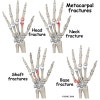
The films should include the entire foot to rule out associated injuries that may require treatment. Radiographs in the anteroposterior (AP), oblique, and lateral planes should be obtained (Figure 3). A neurovascular examination should be performed to assess for any loss or altered sensation and review the vascularity of the foot and the toes. Gently applying an axial load to the metatarsal head will create pain if that metatarsal is fractured and this may help differentiate a fracture from a soft-tissue injury on clinical exam. The relative position of the metatarsal heads should be assessed to rule out malposition and other deformities. Except with major trauma gross deformities are rarely seen.Ī history of direct impact suggests a transverse or comminuted fracture of the shaft, while a twisting-type injury typically causes an oblique or spiral fracture pattern.Ī physical exam should be performed with specific attention paid to the main areas of pain, which usually correlates to the site of injury. Patients with an acute metatarsal fracture present with pain, swelling, ecchymosis, and tenderness to palpation in the forefoot - along with difficulty bearing weight. Most metatarsal fractures result from an acute injury, although chronic stress fractures and neuropathic related metatarsal fractures do occur.
_%BCհ%A1%B6%F4%BF%A1_ū_%C3%E6%B0%DD%C0%BB_%B9ް%ED_%BCհ%A1%B6%F4%C0%CC_%BAη%AF%C1%B3%BE%EE%BF%E4-2.jpg)
This seemingly arbitrary division is clinically important: fractures in each zone have distinct prognoses and treatment needs. Zone 3 is the diaphysis and fractures are most commonly trauma or rotational injuries leading to spiral fractures.įigure 2. Many of these Jones-type fractures are stress-type fractures caused directly or indirectly by repetitive loading to this area. Fractures involving Zone 2, called Jones fractures, are particularly susceptible to nonunion and malunion because this region of the bone has a tenuous blood supply. Zone 2 is at the metaphyseal-diaphyseal junction, distal to the cancellous (styloid) tuberosity. Avulsion fractures from the pull of this tendon and attached ligaments are characteristic of zone 1. Zone 1 is the base of the metatarsal where the peroneus brevis inserts. The fifth metatarsal is divided into 3 zones (as shown), numbered 1 to 3 from proximal to distal (Figure 2). The second, third and fourth metatarsals are slender and may be sites of stress fracture or acute fractures from twisting mechanisms or a direct blow. The first metatarsal is larger than the others and most important for weight-bearing and balance therefore, malunion or malalignment at this location is especially poorly tolerated. There are no interconnecting ligaments between the 1st and 2nd metatarsals, allowing for independent motion. The medial three rays act as a rigid lever to aid in propulsion while the lateral two rays provide some mobility in the sagittal plane to permit accommodation to uneven ground.

As a unit, the five metatarsals serve as the major weight-bearing complex of the forefoot. The bases of each metatarsal also articulate with each other at the intermetatarsal joints.

The base of each metatarsal articulates with one or more of the tarsal bones and the head articulates with the proximal phalanges. They are numbered from 1 to 5, medial to lateral or largest to smallest (Figure 1). The metatarsals are dorsally convex tubular bones of the forefoot consisting of a head, neck, shaft, and base. The metatarsals are also subject to stress fractures and can be seen in conjunction with other injuries of the mid-foot. However, metatarsal fractures that go on to malunion or nonunion can lead to disabling metatarsalgia or midfoot arthritis. Metatarsal fractures are common injuries to the foot often sustained with direct blows or twisting forces. Many of these fractures are easy to treat and have a favorable prognosis.


 0 kommentar(er)
0 kommentar(er)
